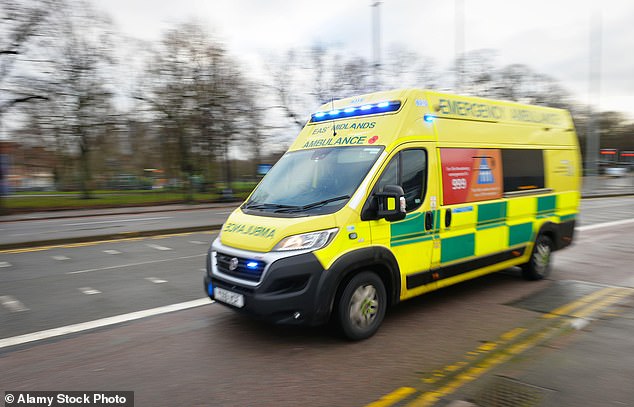More than one in four ambulances are out of service due to maintenance or reliability problems in some areas, research reveals.
Teams warn patients are being forced to wait too long for emergency care as trusts battle crippling staff and vehicle shortages.
Only 78 per cent of ambulances nationally are operational on any given day, a figure which falls to 72 per cent at South Central Ambulance Trust.
Meanwhile, one in ten call handler roles are vacant across the UK, meaning the public faces a delay in applying for help in the first place.
Teams warn patients are being forced to wait too long for emergency care as trusts battle crippling staff and vehicle shortages. Stock
In the worst affected ambulance services, up to 39 per cent of 111 call taking positions and 29 per cent of 999 call taking positions are vacant.
The GMB union said the figures, obtained under Freedom of Information laws, show urgent action is required for the NHS to meet critical performance targets.
Paramedics must arrive at the scene of “category two” calls, including possible heart attack and stroke victims, within 18 minutes.
But the average in March, the last month available, was 33 minutes and 50 seconds, and one in ten waited more than 1 hour and 11 minutes.
For life-threatening ‘category one’ calls, where a patient’s heart has stopped or they are not breathing, the target is 7 minutes, but the average was 8 minutes 20 seconds, and one of each ten wait at least 14 minutes 48 seconds, more than double what they should.
It took ambulance staff an average of 5 seconds to respond to 999 calls in March, but one in 100 people had to wait 76 seconds or more.
And 111 callers faced an average wait of 3 minutes and 16 seconds, with one in ten abandoning their call before it was answered.
Rachel Harrison, national secretary of the GMB, said: “These figures highlight once again the dire state our NHS is in.
‘With hundreds of vacant positions and vehicles out of service, it is no wonder delays are so high.
‘Trusts cannot recruit or retain the staff they need, while workers tell us that high pressure, low pay, hearing damage and abuse are the reasons why staff leave early.
‘We need to act against shockingly low pay and unacceptable working conditions if services meet the standards patients need.
“These statistics also highlight the utter hypocrisy of the government’s minimum service levels legislation – trusts clearly cannot manage service levels of 80 per cent on a normal day.”
A daily snapshot of data from four ambulance trusts in England shows they had 1,333 ambulances in their fleet, but only 1,034 (77.6 per cent) operational, meaning 299 were unavailable for patient use.
Others will have been sitting outside hospitals waiting to hand patients over to doctors in A&E, meaning they were also unable to respond to new calls.
Meanwhile, responses from 11 UK ambulance services show the NHS employs 7,914 call handlers and dispatch operators, but has 772 vacancies for these roles.
The East of England Ambulance Service says it has a 29.2 per cent vacancy rate for 999 call handlers, while South Central says it has 38.6 per cent of its 111 call handler posts unfilled .
Ambulance trusts have warned in board minutes that vacancies and fleet problems are holding back performance and putting patient safety at risk.
The South East Coast Ambulance Service said in February: ‘Call response targets are not being consistently achieved due to recruitment challenges, high staff turnover and poor call performance.
“This creates risks to patient safety, clinical effectiveness, patient experience, colleague experience and the reputation of the Trust.”
The North East Ambulance Service warned in November: “Vehicle availability and park capacity could limit improvements in response time in both the short and medium term.”
And South East Coast Ambulance Service also said in February that a quarter of its double-crewed ambulances were older than expected and that “high vacancies within the vehicle maintenance technician team are affecting the capacity we have to address issues within our workshops.
In some trusts, the arrival of new vehicles has been delayed after Bolton-based ambulance manufacturer VCS went into administration last year.
South West Ambulance Trust said in November that “only 13 of 101 vehicles” had been delivered due to the business failure and warned it may have to write off £2.5m in advance payments.
A Department of Health and Social Care spokesperson said: “The latest NHS data shows that 999 calls are answered faster (with an average wait of just five seconds) and we have 50 per cent more ambulance staff compared with 2010.
“We are also putting 800 new ambulances into service, and last year £200 million was invested to increase services and reduce response times.”
A spokesperson for NHS England said: “Ambulance Trusts in England are working hard to retain existing talent and attract new ones, while the NHS Long Term Workforce reaffirms our commitment to improving the working experience of staff.”
“NHS Ambulance Trusts also take the safety of their ambulances very seriously and have a regular program of servicing and maintenance.”


